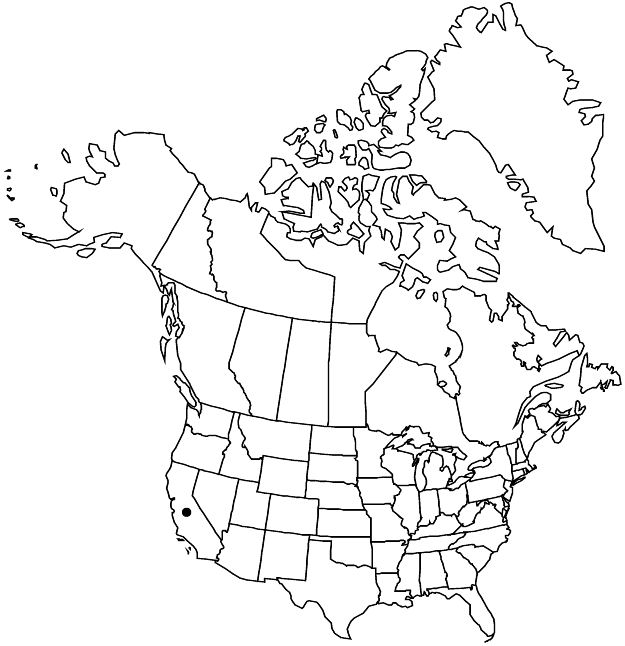Difference between revisions of "Ivesia longibracteata"
Syst. Bot. 14: 233, fig. 1. 1989.
FNA>Volume Importer |
FNA>Volume Importer |
||
| Line 32: | Line 32: | ||
|distribution=Calif. | |distribution=Calif. | ||
|discussion=<p>Of conservation concern.</p><!-- | |discussion=<p>Of conservation concern.</p><!-- | ||
| − | --><p>Ivesia longibracteata is known only from the Castle Crags area of Shasta County. The epithet alludes to a diagnostic characteristic unique in the genus: the epicalyx bractlets are longer than the sepals. The plants grow on vertical rock faces, a habitat more characteristic of sect. Setosae; however, the stems are ascending to erect and do not form hanging clumps, and the pedicels are not curved in fruit.</p> | + | --><p><i>Ivesia longibracteata</i> is known only from the Castle Crags area of Shasta County. The epithet alludes to a diagnostic characteristic unique in the genus: the epicalyx bractlets are longer than the sepals. The plants grow on vertical rock faces, a habitat more characteristic of sect. Setosae; however, the stems are ascending to erect and do not form hanging clumps, and the pedicels are not curved in fruit.</p> |
|tables= | |tables= | ||
|references= | |references= | ||
| Line 56: | Line 56: | ||
|publication year=1989 | |publication year=1989 | ||
|special status=Conservation concern;Endemic | |special status=Conservation concern;Endemic | ||
| − | |source xml=https://jpend@bitbucket.org/aafc-mbb/fna-data-curation.git/src/ | + | |source xml=https://jpend@bitbucket.org/aafc-mbb/fna-data-curation.git/src/8f726806613d60c220dc4493de13607dd3150896/coarse_grained_fna_xml/V9/V9_364.xml |
|subfamily=Rosaceae subfam. Rosoideae | |subfamily=Rosaceae subfam. Rosoideae | ||
|tribe=Rosaceae tribe Potentilleae | |tribe=Rosaceae tribe Potentilleae | ||
Revision as of 18:16, 18 September 2019
Plants green, ± tufted; taproot ± stout, not fleshy. Stems ascending to erect, 0.3–1.2 dm. Basal leaves weakly planar to loosely ± cylindric, (0.5–)2–4(–6) cm; sheathing base glandular abaxially, otherwise glabrous; petiole 0.5–2 cm, hairs 0.2–1 mm; leaflets 5–6 per side, 2–6 mm, ± short-hirsute, glandular-puberulent, lobes 2–7, oblanceolate to spatulate or obovate, apex not setose. Cauline leaves 1–3, not paired. Inflorescences 3–14-flowered, 1–2.5 cm diam.; glomerules 1. Pedicels 1.5–6 mm. Flowers 8–10 mm diam.; epicalyx bractlets linear to narrowly lanceolate or elliptic, 2.5–5 mm, longer than sepals; hypanthium shallowly cupulate, 0.5–1 × 2–3 mm; sepals 1.5–2.5 mm, ± acute; petals pale yellow, linear to narrowly oblanceolate, 1.5–2.5 mm; stamens 5, filaments 0.7–1.3 mm, anthers yellow, 0.5–0.8 mm; carpels 6–11, styles 1–1.5 mm. Achenes cream to light tan, 1.2–1.5 mm.
Phenology: Flowering summer.
Habitat: Dry crevices of granodioritic igneous rock, in mixed oak-conifer woodlands
Elevation: 1200–1400 m
Discussion
Of conservation concern.
Ivesia longibracteata is known only from the Castle Crags area of Shasta County. The epithet alludes to a diagnostic characteristic unique in the genus: the epicalyx bractlets are longer than the sepals. The plants grow on vertical rock faces, a habitat more characteristic of sect. Setosae; however, the stems are ascending to erect and do not form hanging clumps, and the pedicels are not curved in fruit.
Selected References
None.
